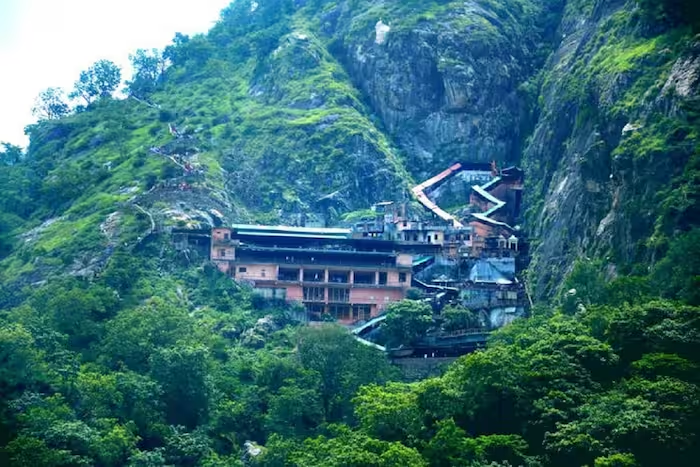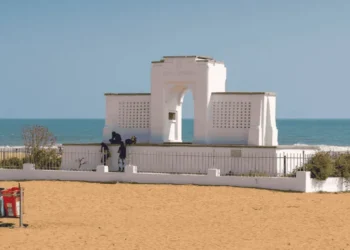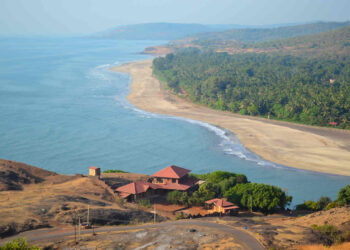Nestled in the rugged Aravali mountains where Pali and Rajsamand districts meet in Rajasthan, the Parshuram Mahadev Temple stands as a holy site if worship dedicated to Lord Shiva. Tied to Lord Parshuram, the sixth avatar of Lord Vishnu, this cave temple draws devotees and travelers with its ancient roots, spiritual depth, and striking natural setting. Perched at 3,995 feet, it offers a quiet place for worship and reflection.
History of Parshuram Mahadev Temple
The Parshuram Mahadev Temple is believed to have been created by Lord Parshuram, who, local tradition says, carved the cave out of Aravali rock to pray to Lord Shiva. No written records mark its exact founding, as its origins lie in Hindu mythology rather than historical texts.
The main cave sits in Rajsamand district, while the nearby Kund Dham, with its sacred water pools, is in Pali’s Desuri tehsil. Often called the “Amarnath of Rajasthan” for its cave structure, it echoes the sacred feel of the Amarnath shrine in Kashmir. Over centuries, it has been a pilgrimage spot, especially during Maha Shivaratri and Shravan Shukla Saptami, when thousands climb the hills to offer prayers.
Stories Behind the Temple
The temple carries tales that touch devotees’ hearts. One key story tells of Parshuram’s search for forgiveness. After following his father Jamadagni’s order to slay his mother, Parshuram bore heavy guilt. He came to this cave, praying to Lord Shiva before a Shivling that formed naturally in the rock. Above it, a stone shaped like a cow’s mouth, called a Gomukh, drips water steadily, seen as a sign of divine mercy. The water flows year-round in the dry Aravali hills, which locals view as a holy wonder.
Another tale links Parshuram to Karna from the Mahabharata, saying he taught the warrior here. A nearby spot, Mathrakundia, a few miles away, is said to be where Parshuram cleansed his sins, adding to the area’s sacredness. The temple’s nine kunds—water tanks that never dry up—are also part of its lore, believed to be blessed by the gods.
Religious Significance of the Temple
During Maha Shivaratri and Shravan Shukla Saptami, the Amar Gati Charitable Trust sets up fairs with chants, food stalls, and tents for pilgrims. About 900,000 people visit each year, joining aartis at 6:00 AM and 6:00 PM, led by priests with incense and prayers. The temple’s high perch and calm hills make it a spot for quiet devotion, drawing people to seek spiritual connection.
Architecture of the Temple
The Parshuram Mahadev Temple is plain but powerful, shaped by nature more than human hands. The cave, cut into Aravali rock, holds a self-formed Shivling and a natural figure of Lord Ganesha, both central to worship. Old carvings on the walls, including one showing Parshuram fighting a demon, hint at its ancient roots. The Gomukh, dripping water onto the Shivling, adds a touch of mystery, as no one knows where the water comes from. Set in the Aravali hills, the temple is surrounded by green slopes and rocky cliffs, with wide views that lift the spirit. The nine kunds, full of water despite the dry land, stand out as a marvel. Unlike Rajasthan’s grand temples with carved pillars, this cave is simple, a place where devotees can pray and feel close to the divine.
Interesting Facts About the Temple
The Parshuram Mahadev Temple has unique features that set it apart:
- The Gomukh’s steady water drip onto the Shivling, with no known source, is seen as a divine sign.
- The nine kunds stay filled all year, a wonder in the arid Aravali region.
- Ancient wall carvings, like one of Parshuram and a demon, show its mythological past.
- The temple’s nickname, “Amarnath of Rajasthan,” highlights its cave-based sacredness.
- Its link to Parshuram teaching Karna adds a connection to the Mahabharata.
Visiting Information for Parshuram Mahadev Temple
How to Get There
The temple is about 100 kilometers from Pali city and 10 kilometers from Kumbhalgarh Fort, with a few ways to reach it.
By Air: Jodhpur Airport, 73 kilometers away, is the closest. Taxis from Jodhpur to Pali take 2 hours, then another hour to Sadri, the temple’s base.
By Train: Pali Junction, 15 kilometers away, has trains from Jodhpur, Jaipur, or Delhi. Autorickshaws or taxis to Sadri take 30–40 minutes.
By Road: From Pali, drive 100 kilometers on NH 162 to Sadri, about 2 hours. From Kumbhalgarh or Rajsamand, it’s a 10-kilometer trip to a parking spot, then a short walk. Buses or taxis from Udaipur (5 hours) or Jodhpur work well.
Temple Hours
The temple opens daily from 6:00 AM to 7:00 PM, with aartis at 6:30 AM and 6:30 PM. During festivals, it may stay open longer—check with priests or locals.
Best Time to Go
November to February is best, with cool weather (10–25°C) good for climbing. Maha Shivaratri and Shravan Shukla Saptami bring lively fairs but big crowds. Summers (April–June) get hot, up to 40°C, so go early. Monsoons (July–September) can make the 500–700 steps slippery, so bring rain gear and watch your step.
Rules for Visitors
Wear proper clothes: men need shirts, trousers, or dhotis with a cloth over the shoulder; women need sarees or churidar with a dupatta. No jeans or shorts.
- Take off shoes before entering; there’s a place to keep them.
- No smoking, alcohol, or spitting allowed.
- Ask priests before taking pictures inside the cave.
- Entry is free, but offerings for puja help maintain the temple.
- Bring water, a hat, and sunscreen for the trek. Don’t carry food, as monkeys may snatch it.
- The 500–700 steps can be tough, so plan if you have knee or mobility issues.
Nearby Attractions
Kumbhalgarh Fort: 10 kilometers away, a UNESCO site with huge walls and history.
Ranakpur Jain Temple: About 50 kilometers off, known for its marble carvings.
Lakhotia Garden, Pali: A calm spot in Pali city for a break.
Udaipur: A 5-hour drive, with lakes and palaces to explore.
Conclusion
The Parshuram Mahadev Temple in Pali is a sacred spot where faith, history, and nature come together. Whether you come to pray, learn about its past, or see the hills, the temple offers something special. Climbing its steps is a journey into Rajasthan’s heart, leaving you with a sense of peace and wonder.











